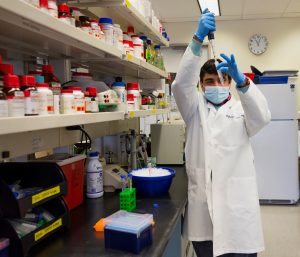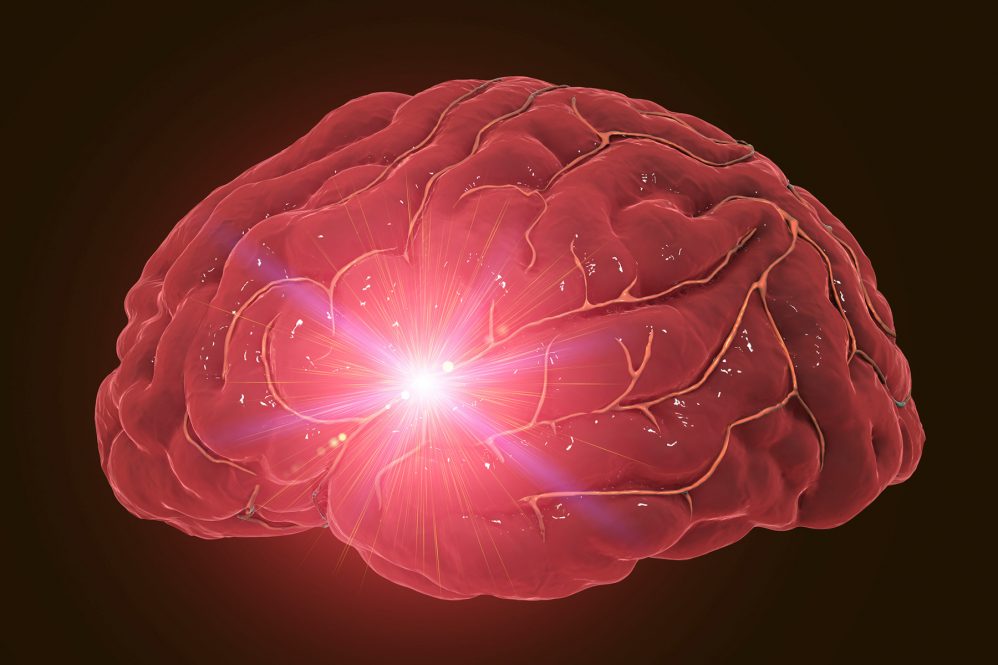Every year, strokes strike 800,000 Americans and are the leading cause of long-term disability in the U.S. because of the lingering brain injury they leave behind. But what if a medication used inside the brain could help heal a stroke’s damage?
Innovative stroke therapy being developed at the UConn School of Medicine aims to inhibit an important receptor implicated in ischemic stroke damage, reducing the brain damage that a stroke inflicts while also expanding the treatment window for stroke victims. It could reduce stroke size and combat stroke effects such as paralysis of one side of the body, speech and language problems, vision problems, and memory loss.

The majority of strokes are ischemic strokes, which occur when a blockage in an artery leading to the brain results in damage or death of brain cells because of reduced blood flow and oxygen supply. The damaged or dying brain cells release excessive amounts of stored adenosine triphosphate (ATP), a molecule that serves as a danger signal, leading to over-stimulation of its receptor P2X4 (P2X4R) mainly found on immune cells of the blood and brain. When P2X4R is overactive, it causes a cascade of detrimental effects in brain cells, leading to a large stroke.
A team led by Rajkumar Verma, Ph.D., assistant professor of neuroscience at the UConn School of Medicine and the Pat and Jim Calhoun Cardiology Center at UConn Health; Dr. Bruce Liang, dean of the School of Medicine and director of the Calhoun Cardiology Center; and collaborator Kenneth Jacobson, Ph.D., of the National Institutes of Health, found inhibiting P2X4R can reduce stroke damage and enhances longer term function in an animal model of stroke.
The researchers have found blocking this receptor for a short time after a stroke limits the overstimulated immune response, improving both acute and chronic stroke recovery. Additionally, this intervention seems to work during this period of over-activation and does not inhibit normal functions of P2X4R during long-term recovery.
“Our mouse model and human cell laboratory research results both show hope for this promising short-term intervention to prevent brain damage immediately after stroke as well as during long-term recovery,” says Liang.
Currently, to limit brain injury after a stroke, a patient must receive an injection of stroke-dissolving tPA medication within 4.5 hours, or have the stroke-causing blockage removed with interventional mechanical thrombectomy surgery within 24 hours. Because of these tight treatment time windows, not all stroke patients qualify for care, leading to many survivors living with permanent injury. At this time, there is no other therapy and new stroke treatment is sorely needed, the researchers say.
Following a stroke, the blood-brain barrier remains leaky and open for several days before resealing itself, according to Verma. This gives practitioners more time to deliver this drug inside the brain.
“This means there is more time available than there is for current treatments, allowing a promising medication like our inhibitors to indeed cross the blood-brain barrier and reach the brain to help heal it,” Verma says.
The team is currently working to make its medication soluble to reach the brain.
“Right now we are working hard to make more potent, blood-brain barrier-permeable inhibitors of P2X4R and testing them in animal models, so that we can begin the process of translating our lab findings to a human trial to treat everyday stroke patients in critical need,” says Verma. “If proven successful in human clinical trial studies, this neuroprotective drug intervention would have a groundbreaking impact on stroke patient care and could even be offered as an additional therapy within a few days of a stroke’s onset to stop stroke damage.
“We are on a mission to bring about a much-needed stroke care solution so every human struck by the debilitating disease can indeed recover, and faster, to regain their daily life functions and independence.”
This research innovation is supported by a small business NIH “STTR phase 1 grant: A New Anti-inflammatory Therapy for Ischemic Stroke” to the company Cornovus with a consortium to UConn School of Medicine under leadership of Liang and Verma.



